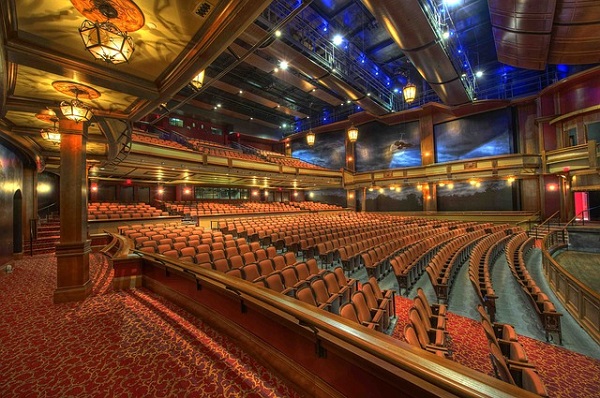In the past, auditoriums were generally purpose-built. Opera houses were designed for opera. Orchestras often share the opera house by adding a stage shell that would aid the orchestra acoustically.

Lecture halls were designed for speech. Movie theaters were designed for sound reinforced by audio from loudspeakers.
Churches were designed for various styles of music and use. Some spaces were built around the required characteristics of a large pipe organ. As liturgical spaces are being repurposed for contemporary music and changing congregations, the results are often not very good.
Multipurpose auditoriums were never really multipurpose.
They were a middle of the road compromise.
When preparing to design a space from an acoustical point of view, the first question that has to be answered is:
What type of performances and uses should it accommodate?
Next Question:
Can I target a style or do I need variable acoustics?
Generalized Examples:
- Unaided speech requires a quiet room, lower reverberation time and strong early reflections.
- Orchestral requires a longer reverb time, extended bass response, and a diffuse room response.
- Contemporary music driven by sound reinforcement requires a completely different room character. In order to allow the sound system to control the experience, the room has to be subdued.
Personal Experience:
Dead Room
Live music can be disappointing in the wrong environment. I remember once I was working with a jazz artist and the auditorium we were booked in was entirely covered in thick fiberglass wall panels. It was dead as a doornail acoustically.
Even when using reverb effects, the room still sounded wrong. The reverb was coming from the PA and the stage monitors, not the room. The side and rear walls were absorbing everything, not adding anything to the sound. Not a great experience.
Overly Live Room
I also remember hearing a favorite artist (Jazz/Bluegrass) in an opera hall. The room was so live it was totally muddled. The sound system could not correct for the overly reverberant room.
How About a Variable Room?
If you build a room with no acoustic variability, as and audience member or performer you are stuck with what you have.
Acoustical Variability to some degree can be accomplished with wall covering drop curtains, rotating walls with various materials, and other options. Physical options can be costly and they can take significant manpower to change for each event type.
Electronic Acoustic Architecture
Most people are familiar with movie theater surround sound. THX, Dolby, Dolby Atmos etc…. These systems create spatial locations for sound sources using a multitude of speakers, each receiving specific information to simulate where the sound would be coming from, or to extend the “feel” of an environment.
While these systems are great for movies, they aren’t deigned to work with a live musical source.
Fortunately recent advances in technology have made it possible to go beyond surround sound into fully simulated live acoustic environments. Imagine you are performing in a relatively plain room with a medium reverberation time and not a lot of lateral energy. Walking the seating area, you find that there are dead spots and changes in frequency balance. Your ensemble sounds a bit thin and lifeless.
Like A Concert Hall
What you want for your ensemble is a much larger room with elegantly tailored wood and brick surfaces, diffusive in nature like a concert hall. Features like these are what makes concert halls concert halls.
Imagine, now, an electronic acoustic system that can create the sound of the room that you are not in.
This Is How Electronic Enhancement Works:
- A series of prearranged microphones pick up the natural sound of the ensemble, organ etc… from a suitable distance so the sound is well mixed. This sound is then processed by a complex computer algorithm that simulates how the sound would behave if it was occurring in a simulated room. This sound is then precisely distributed and tuned to small loudspeakers located to simulate the room you want to mimic.
- Room tunings and character can be changed at will. To the audience, it is entirely natural. It just sounds as if they are in a different room.
- When the orchestra takes the stage, the room gets larger and has added bass extension. The choral group gets a longer reverb time with added midrange clarity. For speech, the system switches to a voice lift mode and can improve intelligibility.
- All of this is controlled by simple presets: Choral, Organ, Speech etc…
In order for electronic acoustics to work, the ROOM itself needs to be designed carefully from an ACOUSTIC standpoint, but in a different fashion.
Discrete echo has to be controlled. The enhancement system works with the room acoustics, but cannot cancel out physical acoustic defects.
Successful implementation of electronic acoustics requires coordination of the system elements with lighting, ceilings, walls, HVAC, plumbing and other elements throughout the design process. HVAC noise has to be very carefully controlled. Led lighting (much of which is now fan cooled) has to be chosen and placed very carefully relative to microphone locations.
The Physical acoustic conditions have to be designed to work with the system. This is not a sound system, it is an acoustic system and placement of all elements are critical relative to the room in which it is employed.
The results are well worth the effort. Performances are enhanced and audiences experience an enveloping detailed sound quality in auditoriums that were previously not.
Copyright AVLDesignsInc 2021+
